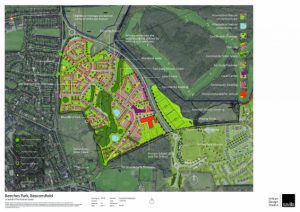The Chilterns Green Belt and its Area of Outstanding Natural Beauty (AONB) remain under unprecedented threat from development despite assurances in the new Government White Paper on Housing, says the Chiltern Society.
The Society, with 7,000 members the leading conservation charity in the Chilterns, is examining the details of the White Paper and the likely consequences on the area and will give a considered response in the Government’s public consultation.
However, Society trustee Paul Mason is concerned that the fundamental problems facing the area remain.
“A tidal wave of tens of thousands of new houses are planned in Buckinghamshire, Hertfordshire, Bedfordshire and Oxfordshire.
“Some of these are on Green Belt and encroach the AONB. The Society is not opposed to the provision of new housing to meet local needs. But for everyone’s sake we must protect the special setting and heritage of the Chilterns. Protected countryside must remain protected.
The White Paper declares the commitment of the Government to the continuing protection of the Green Belt but the Society believes the Government needs to re-examine the way it calculates housing need. The current method puts impossible pressures on councils in the Chilterns, forcing them to make short-sighted planning decisions which damage protected countryside and its setting. The Society will be making this clear in its response to the White Paper.
The Chiltern Society shares the concerns raised by the London Green Belt Council that measures for the protection of the Green Belt may not be robust enough. We also agree with the position expressed by the Campaign to Protect Rural England (CPRE) that MPs and local authorities need to ensure that the commitment to the Green Belt outlined in the White Paper actually translates into achievable targets and appropriate well designed development.
For information : The Government Housing White Paper, titled ‘Fixing our broken housing market’ was published on 7th February and sets out proposals on how the Government intends to boost housing supply and, over the long term, create a more efficient housing market whose outcomes more closely match the needs and aspirations of all households and which supports wider economic prosperity. Specific proposals are made with respect to the Planning Process;
- Making sure every part of the country has an up-to-date, sufficiently ambitious plan so that local communities decide where development should go;
- Simplifying plan-making and making it more transparent, so it’s easier for communities to produce plans and easier for developers to follow them;
- Ensuring that plans start from an honest assessment of the need for new homes, and that local authorities work with their neighbours,so that difficult decisions are not ducked;
- Clarifying what land is available for new housing, through greater transparency over who owns land and the options held on it;
- Making more land available for homes in the right places, by maximising the contribution from brownfield and surplus public land, regenerating estates, releasing more small and medium-sized sites, allowing rural communities to grow and making it easier to build new settlements;
- Maintaining existing strong protections for the Green Belt, and clarifying that Green Belt boundaries should be amended only in exceptional circumstances when local authorities can demonstrate that they have fully examined all other reasonable options for meeting their identified housing requirements;
- Giving communities a stronger voice in the design of new housing to drive up the quality and character of new development, building on the success of neighbourhood planning;
- Making better use of land for housing by encouraging higher densities, where appropriate, such as in urban locations where there is high housing demand; and by reviewing space standards.
As ever, the devil is in the detail of how this will be translated into action. The Chiltern Society Planning Group will be watching closely.





